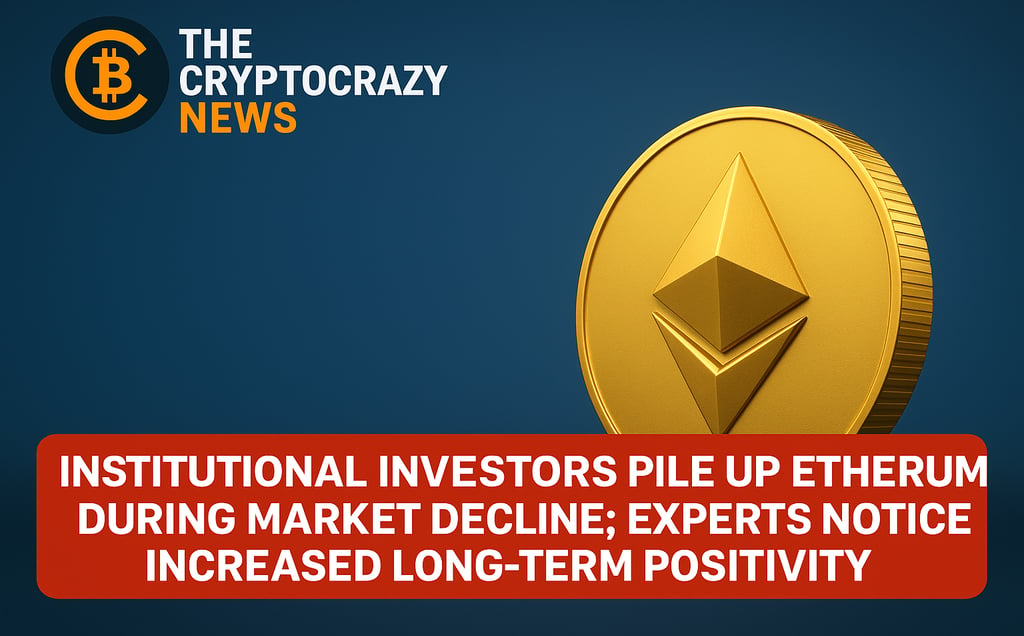Institutional Investors Pile Up Ethereum During Market Decline; Experts Notice Increased Long-Term Positivity
As markets have been witnessing recent volatility and deep pullbacks among leading cryptocurrencies, Ethereum (ETH) is seeing institutional accumulation pile up, an indication of a fresh wave of long-term positivity in the world's second-largest cryptocurrency asset.
10/16/20253 min read


Stats from a number of on-chain analytics tools confirm that institutional pockets and cryptocurrency funds have been gradually adding ETH to their wallets, even while prices continue to be under strain. The action indicates large buyers are seeing the current slump as a calculated purchase opportunity, wagering on Ethereum's long-term growth prospects and increasing utility within decentralized finance (DeFi) and Web3 usage.
Ethereum's Price Correction Seen as a "Healthy Reset"
Ethereum's price has retraced from recent highs in recent weeks amid general market weakness. But most analysts say this pullback is a healthy market adjustment, not a sign of decreasing value.
"Institutional investors are not panicking — they're stacking up," crypto market strategist Hiroshi Tanaka said. "Ethereum's fundamentals are extremely strong, and its place within the blockchain ecosystem is unparalleled."
Based on Glassnode and Nansen data, the number of wallets containing over 10,000 ETH — an important metric for institutional activity — has increased consistently since October began.
The rise represents a strategic move to accumulate during bearish periods, a trend historically observed prior to large Ethereum rallies.
The Institutional Case for Ethereum
Various reasons underpin Ethereum's increasing popularity among institutions:
Transition to Proof-of-Stake (PoS): After Ethereum's successful transition from proof-of-work to proof-of-stake, staking returns and reduced energy expenses have positioned ETH as a desirable asset for long-term holders.
Dominance in DeFi and NFTs: Ethereum remains the foundation of decentralized finance and non-fungible token ecosystems, creating real-world applications and on-chain utility.
Institutional-grade products: The introduction of Ethereum futures ETFs and the growing possibility of a spot ETH ETF approval in 2025 have bolstered institutional confidence.
Strong developer ecosystem: With thousands of working developers and ongoing protocol upgrades, Ethereum is still the strongest and most innovative smart contract platform in the crypto space.
"Ethereum's shift to a yield-generating, deflationary asset has made it progressively similar to digital bonds or technology stocks," said AlphaWave Capital head of digital asset research Maya Lewis. "Institutions see that ETH is not only a cryptocurrency — it's an entire platform."
On-Chain Metrics Indicate Accumulation and Holding Behavior
Ethereum exchange outflows recently hit a multi-month high, indicating that there is increasingly more ETH being transferred from exchanges to cold storage — a definitive sign of long-term holding behavior.
Meanwhile, participation in staking is rising further, with in excess of 35 million ETH currently being locked in the Ethereum network's staking contracts, equivalent to almost 30% of the circulating supply.
These points indicate that even with short-term weakness in prices, market players are gearing up for a long-term bullish scenario.
Experts Anticipate Fresh Momentum
Bloomberg Intelligence and CoinShares analysts forecast that Ethereum may witness a robust rebound in the next few quarters, on the back of institutional flows, fresh developer activity, and perhaps regulatory clarity.
"Ethereum's market structure is consistent with accumulation on key support levels," CoinShares' senior analyst James Ritter has commented. "If Bitcoin's momentum is maintained, ETH might outperform during the next recovery phase."
Most people are of the opinion that Ethereum's future upgrades — such as scalability upgrades through Danksharding and Layer-2 integration — will further optimize network efficiency, reducing transaction costs and increasing adoption.
Investor Sentiment Turning Positive
The change in institutional behavior is also affecting overall market mood. Social metrics and investor sentiment surveys report a higher percentage of traders holding optimistic views on Ethereum's medium-term outlook.
The Ethereum Fear & Greed Index, which gauges investor sentiment, has also started to make a recovery from fear levels, reflecting initial signs of renewed optimism.
Long-Term Outlook: A Strategic Accumulation Phase
Industry experts define the present market cycle as a strategic accumulation phase in Ethereum, and not as a bearish phase. Institutional investors — patient and long-term players — are seen to be positioning themselves in anticipation of the next macro bull cycle.
"Historically, smart money gets built up when prices are low and the sentiment is bearish," said Dr. Kenji Nakamura, Osaka Digital Institute blockchain economist. "Ethereum fundamentals have not degraded — if anything, they're as good as they've ever been."
Conclusion: Smart Money Moves as Retail Waits
As retail traders might continue to hold back with uncertainty in the market, institutional investors are projecting a clear message: Ethereum remains a fundamental pillar of the digital asset economy.
As regulatory definition gets better and infrastructure surrounding ETH continues to develop, institutional buying is expected to be a chief driver of Ethereum's next growth cycle — potentially foreshadowing a new all-time high in 2026.
